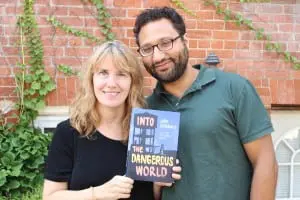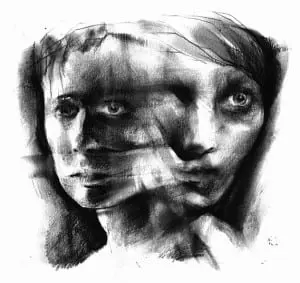Finding your way in 1980s NYC
By Alison Rooney
Julie Chibbaro has already taken her readers along on a 12-year-old’s harrowing voyage to the New World (in Redemption) and, shifting centuries, through a 16-year-old’s pursuit of “Typhoid Mary,” in the name of scientific research (in Deadly). Now, in what may be the darkest of these rides, she is revisiting the far grittier New York City of her own teen years, the 1980s, examining a young artist’s coming of age in the graffiti-led street culture of those times, set against the still-prevalent tugs toward a more traditional educational and artistic upbringing.
Her third young adult novel, Into the Dangerous World (title taken from a William Blake poem), will be published by Viking on Aug. 18. This time, Chibbaro has a collaborator, her husband JM (Jean-Marc) Superville Sovak, whose graphic illustrations punctuate the narrative with a visual urgency. This is the second such collaboration for the Beacon couple, as a number of Superville Sovak’s drawings appeared in Deadly.

photo by A. Rooney
Chibbaro’s Into the Dangerous World protagonist, Ror (short for Aurora), is bruised and resilient, a 17-year-old grappling with the suicide of her father, who burned their house down, dictating the relocation of her remaining family from the leftover of a hippie-era commune to an SRO hotel in New York City. The tugs and pulls of those around her — from adults, including a teacher who urges her to go the traditional college route, to Trey, a fellow art student active in a graffiti crew — confuse her own leanings but ultimately allow her to forge her own way. Far from connoting a sugar coating, the young adult designation currently signifies a hard-edged, realistic depiction of both that time period and the struggles of the soon-to-be young adult the story is built around.

Chibbaro, who grew up in New York City, has been working on Into the Dangerous World for about two decades, here and there. The path an artist chooses to take is at its core, and that has meaning for her, in the context of her own family.
“I come from a family of artists, and I didn’t always understand them,” she explained. “Writing is a way of understanding. The joy is to do the research and to figure out the human drive behind it. What drives them? How do they know they’re any good? How do they find their place in the world? I think this struggle is universal. It helps to be in someone else’s struggle.”
Superville Sovak agreed: “It also starts from someone else’s point of view, and it’s a time of finding things out. As an artist, there’s a special vulnerability at that age.”
Chibbaro decided to set the book in the 1980s because that’s when she herself was in high school, and it coincided with the start of the street art movement. “I wanted to go back to that time when rap and hip-hop and other things which are still popular today, began — when there was a convergence.”
 The book has evolved over the course of many drafts. When Chibbaro first submitted it to her editor, the response was double-edged, with the editor pronouncing, “I love the first 10 pages — the rest not so much.” Chibbaro thought hard about changes and made them, altering a character who was a poet into a graffiti artist, getting rid of lengthy discussions of art and making it more action-packed. Most important was actively tapping into the “energy of teenage struggle. Not asking big questions, but grabbing onto the impulses and obsessions which can dominate teenage life,” she said.
The book has evolved over the course of many drafts. When Chibbaro first submitted it to her editor, the response was double-edged, with the editor pronouncing, “I love the first 10 pages — the rest not so much.” Chibbaro thought hard about changes and made them, altering a character who was a poet into a graffiti artist, getting rid of lengthy discussions of art and making it more action-packed. Most important was actively tapping into the “energy of teenage struggle. Not asking big questions, but grabbing onto the impulses and obsessions which can dominate teenage life,” she said.
Although now categorized as a young adult author, Chibbaro wasn’t even aware that she was one until she submitted Redemption. “I wrote the book from what just happened to be a 12-year-old’s perspective. My agent said, ‘It’s a Young Adult book,’ and she wound up selling it as a two-book deal, so I basically needed to write another young adult one … So now, with this one, I’m basically considered a young adult author. A lot of teachers and librarians are the gatekeepers for young adult fiction, and I hear from them a lot. I have many adult readers, too.”

Asked if teens and adults responded to her books in different fashions, Chibbaro said, not really, that they react similarly, perhaps because teens reading young adult works “tend to be really good readers.”
One might assume that an author has to tone it down if targeting a book at the young adult market, but Chibbaro said the opposite is true. “I don’t watch my content at all, and I don’t think it’s a good move to, because if you pander, it dumbs it down. In fact, my editor told me to make it more gritty; you have to be authentic,” she explained. The editor used teen focus groups, which produced useful advice, such as pointing out when there is an adult worry voiced (in the text) that might not necessarily be a teen worry.
Superville Sovak’s drawings were done after the first draft of the book was completed. After a pitch with some mock-ups was submitted to an agent, Chibbaro began rewriting, and then the drawings came in, often based on simple one-sentence description of characters. They tried writing and drawing it together, concurrently, but found that method didn’t work for them.
“I’d do a sketch in pencil, or a couple, we’d look at them, sometimes I hit a bull’s-eye, which was great — I would finish them,” said Superville Sovak. “But it was essential to be malleable, to erase, tweak, add, in some cases digitalize the work in order to keep it as supple as possible.”
The interpretation of her characters and story in drawing form inspired Chibarro, too: “When I started to see the drawings, it opened up the text,” she said.

The biggest challenge for Superville Sovak was “to take the idea of the story and put it into a format which would work on a 6-by-9-inch page.” Figuring out how to render an illustration of spray paint in a way to actually look like spray paint was another hurdle, with a solution found in doing actual spray painting, then photographing it.
Though the book is being promoted at comic conventions and other strongholds of alternative teenage artists, Superville Sovak noted that the central character, Ror, holds “no superpowers other than her imagination and crazy ambition, but she’s definitely a superhero.”
Into the Dangerous World will be celebrated at a book launch party at Beacon’s Howland Library on Aug. 22 from 1 to 3 p.m. Chibbaro will read from the novel, and T-shirts and copies of the novel will be available for purchase, along with signing opportunities by both the author and artist. Period refreshments will highlight a 1980s dance-party-style event. All ages are welcome and no registration is required to this free event.
For more information, visit juliechibbaro.com or intothedangerousworld.com.

